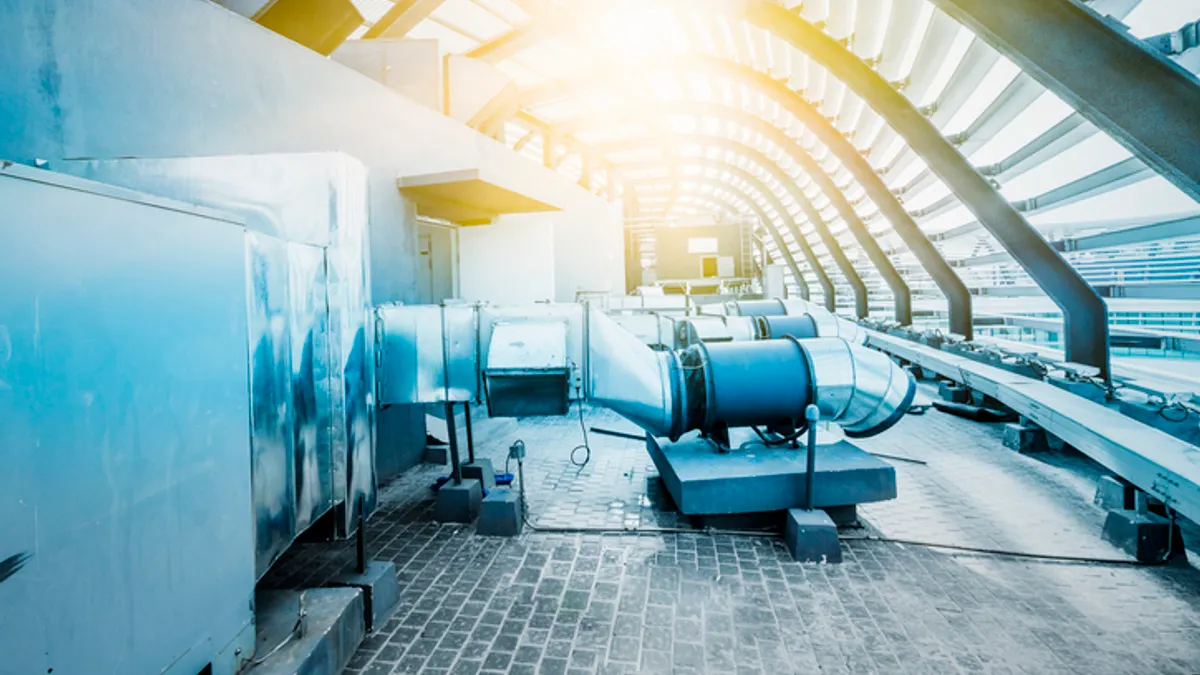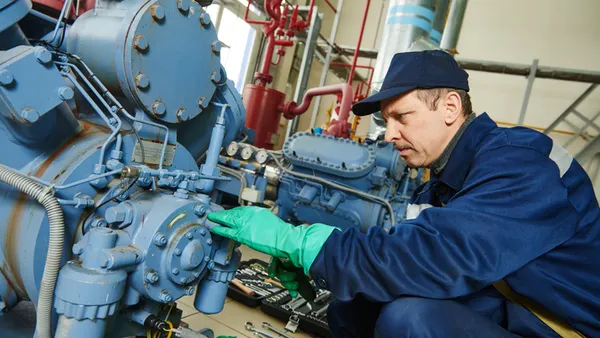Facilities operations became part of a semiconductor manufacturer’s financial turnaround when it stabilized its energy costs by putting in a microgrid, says Charlie Lord, managing principal at Renew Energy Partners, an energy-as-a-service company.
The publicly traded manufacturer had been struggling with financial challenges caused in part by the unreliability of the utility grid it was counting on for its energy, Lord told Facilities Dive.
“They were dealing with a bunch of micro-outages because the grid was – and still is – unreliable in that corner of the grid, and for every outage they lost half a day and $1 million in revenue,” said Lord, whose company provides energy solutions to manufacturers and other industrial and commercial property owners.
Once the manufacturer put in a cogeneration and battery array microgrid, which Lord’s company financed, it was able to replace the unpredictable availability and price of energy for a large portion of its daily needs with a predictable and lower-cost alternative source, Lord said.
By itself, the stabilized cost was modest. But when coupled with other business and operational changes the company was making, it was enough for the company to improve its credit rating to investment grade after years of being below that threshold.
“It actually was a little piece of their turnaround,” Lord said. “We reduced their costs. We dramatically improved the pro forma of the facility that was dealing with a bunch of outages.”
Renew works with commercial property owners to make energy design changes that aim to increase the efficiency of their HVAC and other systems. As an EaaS company, it finances and owns the upgrades.
“Our customers will tell us what their priorities are for these projects,” said Lord. “An interesting shift we’ve seen in the last five years is they’ll often now say, ‘I will do any project that keeps my operating budget the same’ rather than try to lower their costs.”
The reason for the shift is the value they get in other areas of their operations in addition to lower energy costs that spin off from the upgrades.
“They’re interested in upgrading equipment that they know needs to be upgraded,” he said. “So, that’s a capital avoidance. They’re interested in carbon and emissions reductions because they’re getting pressure from customers or buyers or limited partners. They’re interested in the resilience and the reliable energy costs they get by avoiding price spikes.”
When Lord’s company works with property owners, it will bring in a design-build partner. Together, the companies will determine the mix of upgrades that will meet the goals of the owner. Renew serves as the hub, providing the financing, managing the contractors and owning the result.
“We are the central shop,” he said. “We think that’s an important attribute of a good partner – someone who can provide the capital and help manage the complexity by saying, ‘Let’s look at all of it and help you figure out what to do and we’ll be your point of contact for all of it.’”
For middle-market companies and larger, typically with multiple properties, Lord’s company will execute a master energy services agreement at the corporate level and, for the mix of work that needs to be done at each facility, add a project addendum. That’s a structure that keeps legal costs and paperwork to a minimum, he says.
“Each one of these project addendums will be linked to a design-build contract and we will fund that contract to get the work done,” he said. “We’ll also fund the ongoing operations and maintenance and we’ll optimize the performance of the system.”
Monetizing waste heat
One of Renew’s specialty areas is thermal energy. It will execute a thermal energy purchase agreement, which Lord called an analogue to widely used power purchase agreements. The difference is the thermal agreement focuses on heat.
“In the same way that, say, a solar array would deliver a meter and charge for a kilowatt-hour, we’re capturing waste heat that’s otherwise going up, say, a smokestack and, through our system, redelivering it to meet the company’s thermal need,” he said. “That’s a therm that isn't being produced by natural gas or whatever the fuel source is.”
Thermal energy purchase agreements can make sense for any type of commercial property that generates excess heat but they tend to be used mostly by manufacturing companies that throw off a lot of waste heat as part of their business processes, or by hospitals. Senior facilities that have staff working 24 hours a day also tend to generate a lot of waste heat.
These thermal projects lower costs, even after including an annual inflation adjustment, and replace unpredictable grid costs with predictable costs, according to Lord.
“When we sign a contract, we’ll set a price per therm,” he said. “There may be a 2-3% escalator for inflation. Typically, that’s driven by our expectation that the cost of maintaining this will go up every year, which it has. But if you know that you’re going to buy half your therms for the next 15 years from a contract that’s going up at exactly 2% or 3% a year, guess what? The other half is still subject to market conditions from the utility, and that may go up 15% in one year.”
That scenario has happened in a number of states over the last two years, Lord said. “So, you’re taking half of your load and saying, ‘I know exactly where it’s going to be.’ You can say that to the CFO. ‘I know exactly what this energy’s going to cost us, every year for the next 15 years. So, we’ve only got half now that’s exposed to that volatility.’ And CFOs love predictability.”





















